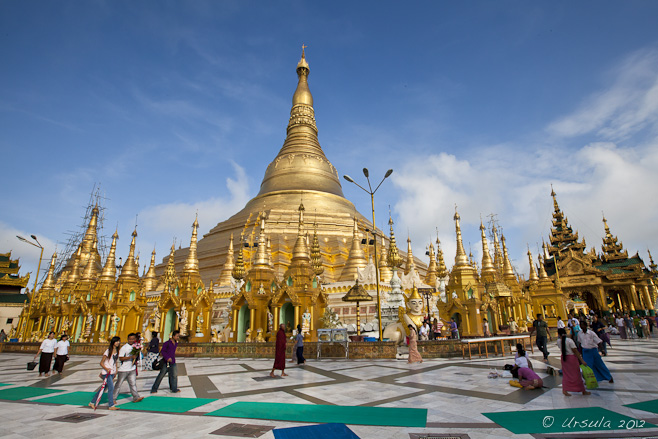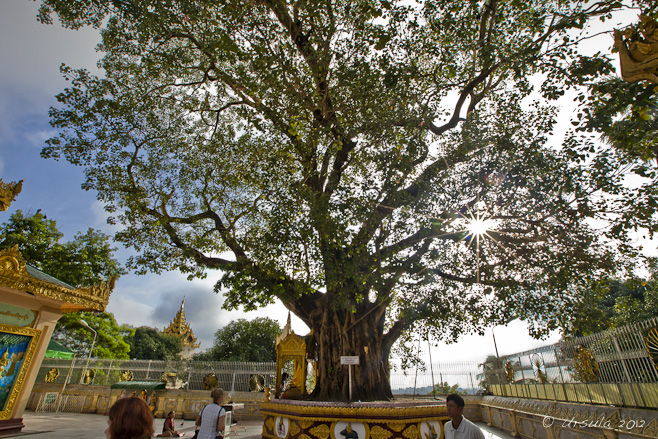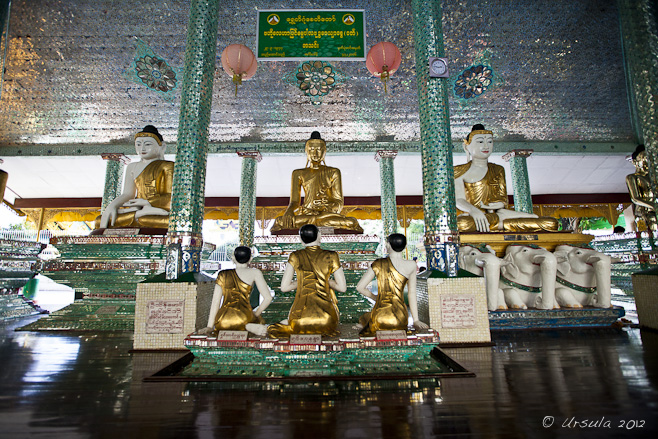
Shwedagon Zedi Daw, the 99 meter gilded pagoda situated on a hill in Yangon, is the most sacred of Myanmar’s Buddhist sites.
“Then, a golden mystery upheaved itself on the horizon, a beautiful winking wonder that blazed in the sun, of a shape that was neither Muslim dome nor Hindu temple-spire. It stood upon a green knoll, and below it were lines of warehouses, sheds, and mills. Under what new god, thought I, are we irrepressible English sitting now?”
~ Rudyard Kipling, 1889
Shwedagon Pagoda (Shwedagon Zedi Daw) is possibly even more magnificent now than it was when Kipling first saw it.
Situated west of Kandawgyi Lake, high up on Singuttara Hill, its golden dome, reputedly tipped with 5,448 diamonds nd 2,317 rubies, can be seen from almost anywhere in Yangon. It is so much part of the Burmese psyche that Queen Shinsawbu (1394–1472), who donated her weight in gold to repair and maintain the pagoda, had her bed positioned so she could look at it during her final days. By the early 16th century, Shwedagon was the most important Burmese Buddhist pilgrimage site, and in more recent years it has also become a centre – and a symbol – of nationalist and political protest.

Morning light in the sacred Bodhi Tree near Shwedagon’s South Entrance.

Luminous white marble Buddhas, lavishly trimmed with gold, in a shining hall.
Shwedagon Pagoda is revered by Burmese Buddhists because it is said to contain the relics of the present Gautama Buddha and the three Enlightened Buddhas immediately preceding Him. Legend has it that two Burmese brothers, Taphussa and Bhallika, met the Lord Gautama Buddha in BC 588 and were given eight of His hairs as sacred relics. When they returned to Burma, the presiding King helped them find the site of the older relics enshrined on Singuttara Hill, and the stupa was built – making it over 2600 years old; thus the oldest pagoda in the world.
Historians and archaeologists, however, suggest that the the pagoda was built by the Mon people between the 6th and 10th centuries CE.
Either way, the original site is old, and improvements and renovations of the pagoda and the surrounds have continued over the years.

Looking up to the birds, the spires and the heavens…

A Burmese woman, wearing thanaka on her face, sits in the shadows of the hallway.

A monk saying morning prayers.

Reflections in a golden Buddha
Burmese Buddhist ritual is strongly rooted in astrology which originated from Hindu Brahmanism. According to Myanmar astrology, the week is divided into eight days (Wednesday is split into two parts) and a person’s fate is dependent on the planet ruling over the day of their birth. The base of the pagoda is octagonal, allowing for eight planetary posts, each with a guardian angel or deva, and a small Buddha in a shine. The faithful, who may bring offerings with them, make their devotions or entreaties at the post which corresponds to the day of their birth.

A Burmese monk quietly sitting with his alms (begging) bowl.

Faithful often bring offerings when they say prayers at their planetary post.

Each of the eight posts has lit candles and incense burning.


There are monks in every nook and cranny.

A monk shields his face from the bright morning light as he walks around Shwedagon Pagoda.

A visiting nun pauses to have her photo taken.

There are 64 alcoves around the base of the pagoda; most with Buddha images, many with monks.
We – the intrepid Karl Grobl and ten photographic enthusiasts – visited Shwedagon Pagoda twice on our brief stay in Yangon: once in the morning and once in the evening. We wanted to witness the life of the pagoda, rather than just its intrinsic beauty, and our guide Mr MM assured us that those were the times that would be busiest with Burmese pilgrims.
I was lucky enough to engage in conversation with locals on both visits. In the morning, I met a man who was there because it was his wife’s birthday, and she wanted to make merit. He had lived in both the USA and Thailand as part of a diplomatic family, and we were able to discuss (albeit cautiously on my part!) the impact of the recent political changes. In the evening, I chatted to a young monk about life, religion, and the cultural importance of Shwedagon, as we took refuge from the rain under an awning.

A bilingual Burmese monk, and his not-so-bilingual friend.

A little afternoon rain doesn’t dampen the faithful who have their umbrellas handy.
There were few tourists around, but the locals were out: the same umbrellas that protected visitors from the harsh morning sun now shielded them from the soft evening rains.

At each of the eight planetary posts, there were Burmese buddhists washing the little Buddhas; …

… this both pays homage to the Buddha and cleanses oneself of sins.

As the rain falls and the light drops, we spot monks on the pagoda “terraces”, just below the “bell”.

A reclining Burmese Buddha.

Detail: gilded columns in one of the many halls.

Incense and evening worship.

Night lights over Shwedagon.
While there is some argument that the riches in the pagoda could be used for much-needed infrastructure development, it has survived early Portuguese pillaging, two wars with the British and years of colonial occupation, as well as earthquakes of varying severity.
 The military government clearly knows the importance of Shwedagon to the people of Myanmar: in 2006 they commenced work on Uppatasanti Pagoda, an almost-exact replica in Naypyidaw, the new capital of Myanmar. In September 2007, they attempted to restrict access to the Shwedagon Pagoda, leading to clashes between security forces and protesters – mostly monks and nuns – which resulted in at least five dead.
The military government clearly knows the importance of Shwedagon to the people of Myanmar: in 2006 they commenced work on Uppatasanti Pagoda, an almost-exact replica in Naypyidaw, the new capital of Myanmar. In September 2007, they attempted to restrict access to the Shwedagon Pagoda, leading to clashes between security forces and protesters – mostly monks and nuns – which resulted in at least five dead.
It still stands tall, a glittering jewel that seems to symbolise Burmese resilience and hope for the future.
Photos: 12September2012




























.png)


As always, informative @ beautiful
I remember my visit 7-8 years ago. Spectacular. Wonderful pictures to stir the memories. Thank you
Beautiful as always, as funny as this is, I asked myself the same question as we neared the end, the … what if the money was redirected etc etc… but it occured to me, without faith, what material objects could these people have that would mean more or be as important, I can’t think of anything one could own that would be more important that how one feels. The history, the sensibility and the devotion can not be equalled.
Thanks, Signe, for putting it so succinctly! Without faith (in something), life becomes empty. “He who has a why for life can put with any how.”
– Frederick Nietzsche
Thanks for the visits, John and Gabe. The place had me awestruck!
And Hobbes said … The condition of man is a condition of war of everyone against everyone and the life of man is solitary, poor, nasty, brutish, and short. (Leviathan) But your Nietzsche quote is more uplifting!
I spent the summer of 1984 in and around Yellowstone, primarily flyfishing but also taking some time out for exploring. It is an absolute must-visit for anyone who enjoys and marvels at natural wonders.
But back to Thomas Hobbes … I was resting one evening (all alone I thought) by Lewis Lake in the southwestern part of Y/Park in a little cove when two guys drove up to the lake, walked around a bit and then discussed what a waste it was that all that prime real estate was locked up in a public park. They speculated how they could sell lake-front plots for a huge profit and make a killing. I guess some people don’t realize that sound carries very well over still water. I was pretty naive at that time and was actually horrified that somebody would think to do that to an incomparable public treasure. Now, I know better–we are generally inclined to destroy, not preserve and enhance.
Thanks for the memories, Ursula, and hope to see you again soon in Thailand.
Selim, as depressing as your observations are, you always make me smile! 🙂
[…] source – https://www.ursulasweeklywanders.com/culture/the-heart-of-myanmar-shwedagon-pagoda-yangon/ […]
[…] Pagoda Shwedagon. Image via: ursulasweeklywanders.com […]